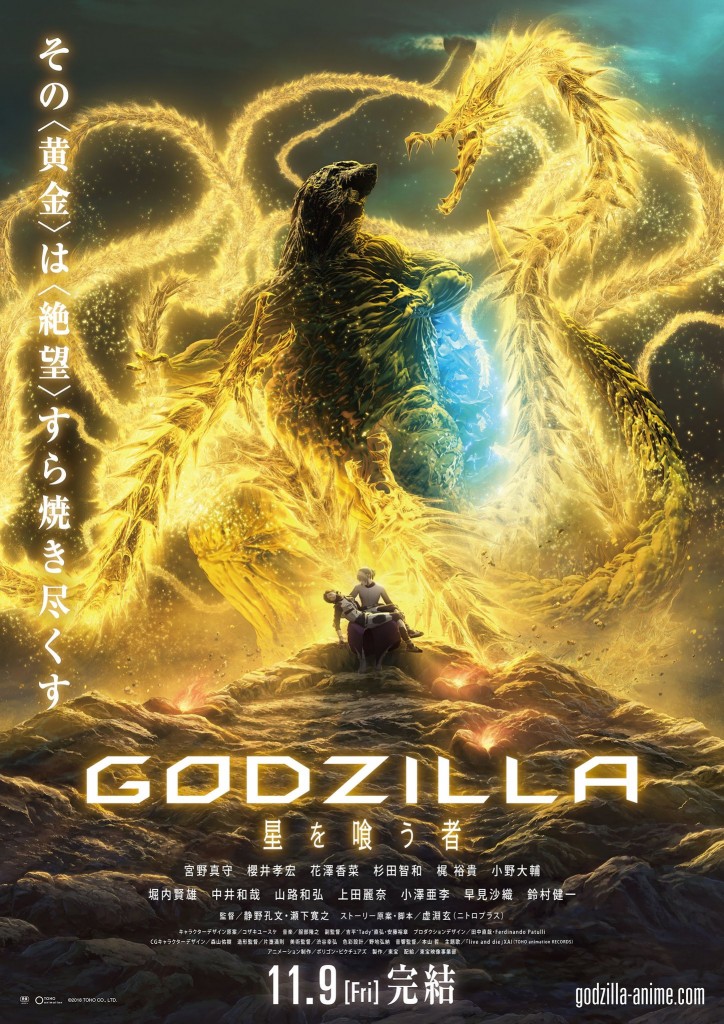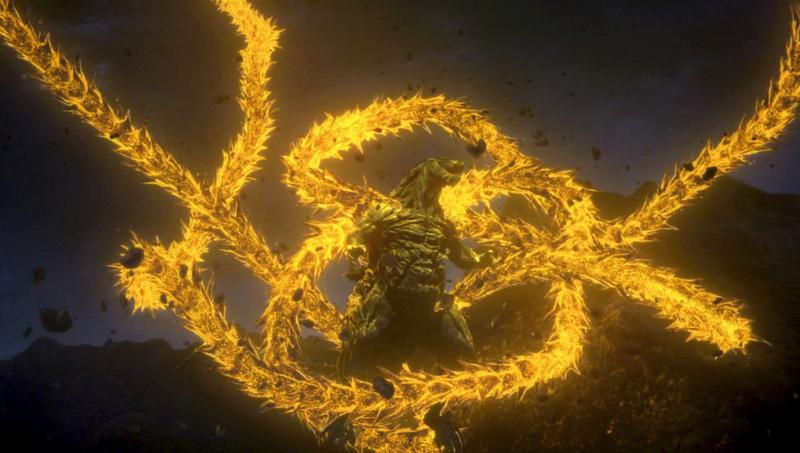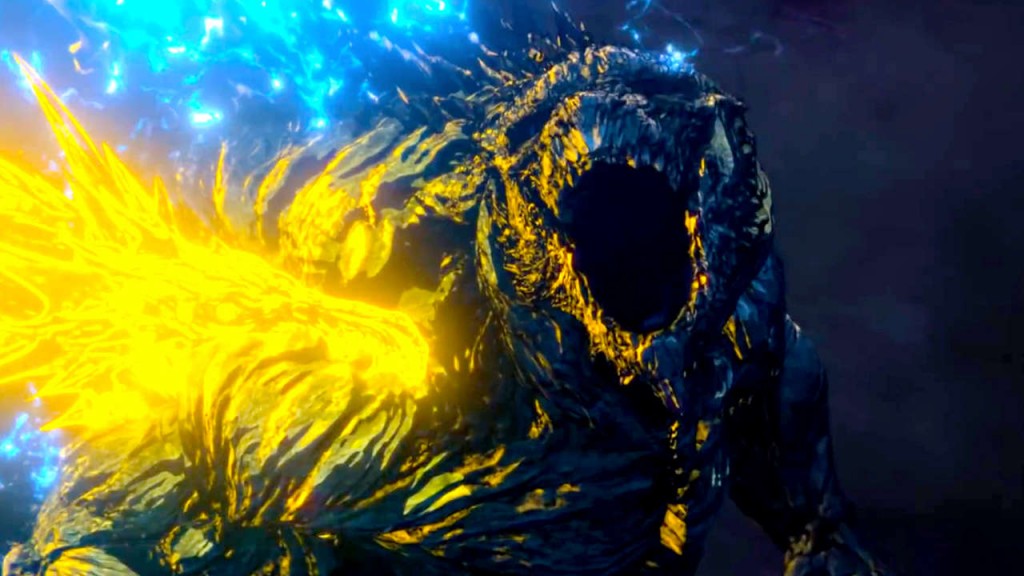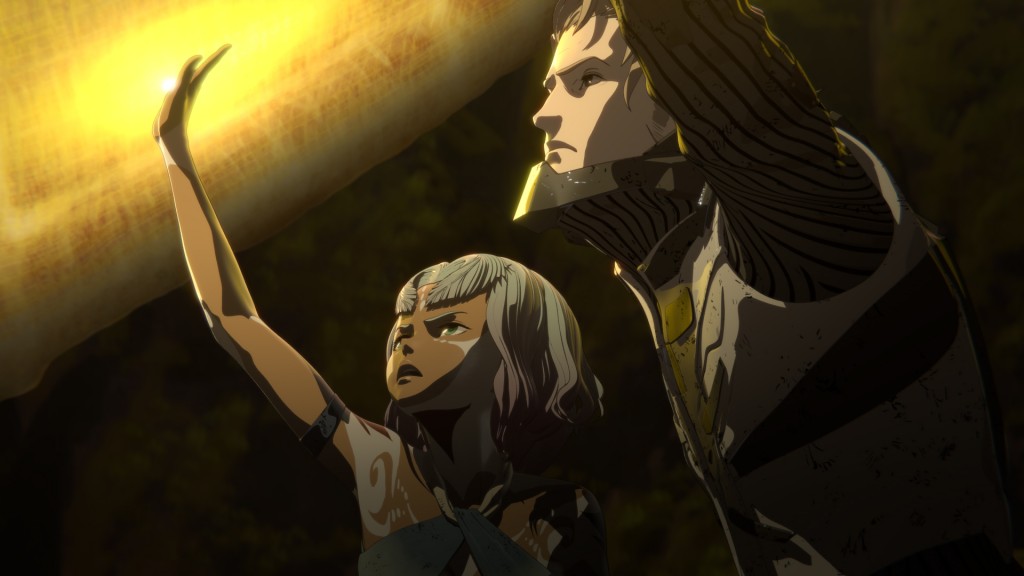Godzilla: The Planet Eater (2018) Brings the Anime Trilogy to a Dreary End
This whole thing has been a lot of pixels over nothing.
Interesting possibilities glimmered in the first two films of the animated Godzilla trilogy, Godzilla: The Planet of Monsters and Godzilla: City on the Edge of Battle. But the final installment has arrived, premiering on Netflix this Wednesday, and now the whole enterprise reveals itself as a water-treading, self-proselytizing, character-inhibited, medium-wasting drag. This hasn’t been a bit of fun. There are no moments of elation or astonishment. In fact, Godzilla has hardly moved. I think the monster budged about ten feet the entirety of this last movie — and that includes during the climactic clash with Ghidorah, the only other kaiju to wander into the trilogy.
Godzilla fought Ghidorah — and for the first time ever, I didn’t care.
It astonishes me how static this “animated” film is. If you want your anime about a giant monster on an apocalyptic Earth to start with thirty minutes of talking heads debating the same philosophical ideas without doing anything about them, and then climax with more talking heads discussing a still-life of two monsters, Godzilla: The Planet Eater (Gojira: Hoshi o kuu mono) is the movie for you. I.e. it’s a movie for nobody, Godzilla fans least of all.
Godzilla: The Planet Eater ends a story that started as an intriguing concept. Not only would the trilogy bring Godzilla to anime for the first time, where budget couldn’t block the imagination of the filmmakers, but it would place Godzilla in the fresh setting of an apocalyptic science-fantasy future. When I first heard the series synopsis — the human race returns to a Godzilla-conquered Earth after an exile in the stars — it got my imagination churning. I envisioned an Edgar Rice Burroughs or Andre Norton environment with the colorful wildness of some of the Godzilla comics.
But the anime trilogy rapidly showed it was more interested in batting around pretentious philosophy than digging into a weird Earth and a majestic God-King Godzilla. The Planet Eater makes the problems with Polygon Picture’s approach painfully apparent; it retroactively makes we wonder if there was anything decent about the first two movies. I originally unearthed a few positives to say about them, but I might have fooled myself.
I can say this with 100% certainty: I never want to watch any of these films again. And I’m someone who’ll happily sit through another viewing of Godzilla vs. Megalon, arguably the worst entry of the Japanese franchise. The anime Godzilla offers nothing to absorb on a second watch, not a single moment I want to relive.
The Planet Eater begins with the same set of unresolved problems left over from the first two movies. The settlers and crew of the spaceship Aratrum are surveying the ruins of their second botched job at destroying Godzilla, and everybody’s pointing fingers. The Exif, the alien race who follow a mathematical religion, have their own plan for Godzilla’s destruction and find converts among the humans to their cult. Metphies, the chief Exif priest, believes Captain Haruo is the key to their plan to bring their destructor god, Ghidorah, to Earth to challenge Godzilla — and possibly bring about the end of the planet.
A few other plots bounce around. Haruo gets involved in a romance with one of the native girls of the Houtua people. The technology-obsessed aliens, the Bilusaludo, seize control of the Aratrum when the humans won’t condemn Haruo over his part in the fiasco at the end of previous movie. But like most plot strands in the anime trilogy, the script sheds ideas quickly without resolution. The conflict comes down to the Exif summoning Ghidorah to Earth and Haruo having to decide his part in it.
Haruo is the biggest sticking point in the movies. Few of the characters register beyond surface appearances (and the animation designs aren’t effective at differentiating them), but Haruo is the most conspicuous failure since he’s supposed to be the hero at the core of it all. Haruo is angry at Godzilla, and that’s the most I can say about him. The script tries to use this monolithic trait as a theme and makes much of Exif’s maunderings about how human hate, and Haruo’s hate specifically, is what created and sustains Godzilla. This makes Haruo vital to the Exif’s plan of harvesting the planet with Ghidorah, although how isn’t clear, and Haruo is such a cipher there’s no reason to make an effort to understand it. The finale and coda depend on viewer investment in Haruo, and he has nothing to offer.
A germ of development emerges in Haruo’s relationship with one of the native Houtua girls (Maina, I think, or maybe Miana?), although it only scrapes “passable” as a romance and a meager improvement over his connection to Yuko in the previous movie. A sense of genuine emotion struggles to come out of the scenes between Haruo and Miana (or Maina?), but like so much else in the movie, it never gets there.
It’s still better than the stories around the characters of Martin Lizzari, Matt Bindewald, and Eliot Leland. They’ve appeared in all three films and I still can’t identify any of them or remember what they stood for in these philosophical debates — if anything.
Ghidorah is one of the few highlights, at least in concept and design. This is the most radical reinterpretation of Godzilla’s great nemesis, although the core of it goes back to the monster’s first appearance in Ghidorah, The Three-Headed Monster. In that movie, Ghidorah was a cosmic wrecking force, a god of destruction who traveled from planet to planet to lay waste to civilizations. The Planet Eater makes Ghidorah a transdimensional entity whom the Exif worship as a god, the deity who comes to “harvest” a world at the end of its lifecycle.
Ghidorah no longer has a body; it manifests as three strands of golden energy with dragon heads at the ends. The sight of these serpentine creatures slithering from black globes in space is the best visual in the trilogy, adding color to the dingy soup of the movies. The first emergence of Ghidorah leads to an effective shock that’s the only surprise the film packs.
Then the monster fight starts, and any hope Ghidorah was going to turn this trilogy around in the last moments dies as the movie goes into lockdown mode and stays there, daring viewers not to walk away and do an inventory of the fridge. This may be the worst monster “fight” in Godzilla history, because it is completely stationary. Ghidorah’s three heads latch onto parts of Godzilla’s body, and then the two beasts just stay there … for fifteen minutes. Haruo falls into a trance with Mephies and the other humans jabber about how they don’t understand the physics of Ghidorah — and it drones on and on and on as the monsters do nothing at all but pose for digital wallpapers.
Those earlier hints about Mothra making an appearance — they do come to something. Barely. An egg, a shadow, a sound. A quick solution to the long hallucination interrupting the monster non-fight. That’s it. Another exciting concept tossed away, with the Toho monster most suited to animation reduced to a black silhouette.
At some point in any kaiju film, the people need to get out of the way and give the great beasts time to dominate. The monsters are what the movies are supposed to be about, and although a screenplay can find ways for people to fiddle around on the fringe with science and military equipment, the monsters must become the protagonists. The anime trilogy has never given Godzilla this space, which is doubly damning when the people are such blanks. The inert fight with Ghidorah is the epitome of how the anime series misunderstands the kaiju genre, leaving me with the disheartening feeling the filmmakers never cared about Godzilla in the first place.
What a waste of the medium and the monster. You can throw in as many heavy science-fiction themes about spirituality, the cycle of history and destruction, and cosmic punishment as you want into your giant monster movie, but they won’t mean anything with flat characters and monsters who exist only to be topics of boring conversations.
So The Planet Eater and its siblings are a let-down and an empty hole on the Big G’s filmography. Eh, I’m used to it. I’m a Godzilla fan. The highs and lows of this series — now with thirty-two entries, not counting the two US films — mean fans never know what they’re going to get when a new movie comes out. It might be dark and memorable. It might be a fist-pumping thrill ride. It might be a circus of stupidity. It could just be dull, like this.
But with Godzilla, there is always the next film … and the next is going to be here in only a few months with the mega Hollywood project Godzilla: The King of the Monsters. It doesn’t look like Ghidorah is going to stand still for that one!
Toho has no new Godzilla film on their schedule, but they’ve announced plans for a “World of Monsters” project starting in 2021 which will build up a shared kaiju universe. This is odd since the original Godzilla films were already part of a shared universe. It was one of the first shared universes, along with the Universal Monsters in the ‘30s and ‘40s. But “shared universe” is the goal every studio is chasing, and if this means Toho gets back to live-action Godzilla with plenty of monster fights, so be it.
Ryan Harvey (RyanHarveyAuthor.com) is one of the original bloggers for Black Gate and has written for the site for over a decade. He received the Writers of the Future Award for his short story “An Acolyte of Black Spires.” His stories “The Sorrowless Thief” and “Stand at Dubun-Geb” are available in Black Gate online fiction. A further Ahn-Tarqa adventure, “Farewell to Tyrn”, is available as an e-book. Ryan lives in Costa Mesa, California. Occasionally, people ask him to talk about Edgar Rice Burroughs or Godzilla.




Color me disappointed but not exactly surprised.
The makers of this trilogy should retire to a corporate retreat and contemplate how they could possibly have made three Godzilla movies about which Ryan Harvey wrote…
“I can say this with 100% certainty: I never want to watch any of these films again.”
This is grievous. I would have thought it all but impossible.
I’ll tell you: My 7-year-old son is a HUGE Godzilla fan. But he DOES use the remote to fast forward to the “good scenes.” He was so excited when he saw this one pop up on Netflix…started fast forwarding…and there’s really nothing to fast forward to.
You bring in King Ghidora to battle Godzilla — and then the battle consists solely of Godzilla paralyzed like a statue while three Ghidora snake necks just suck on him? And THAT’S IT? WTF?
In the writers’ room: “We know they’re releasing a big-budget, live-action film this year that’ll feature big battles with Godzilla, King Ghidora, and other kaiju — so we can skip all that. We’ll use our two hours to just have some serious talking.”